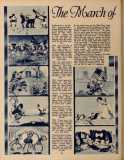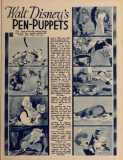It was twelve years ago that Walt Disney made his first film, and he has followed it with nearly two hundred, not one of which has been a "flop." Disney is modest as well as clever. He claims that the public made his stars, not himself, and insists upon credit for his staff, whose devotion and loyalty he has well earned. The first Mickey Mouse film was made in a garage, and Disney says that Charlie Chaplin was his inspiration. He knew that the public liked little animals, so, in his own words, "I thought of a tiny bit of a mouse that would have something of the wistfulness of Chaplin — a little fellow trying to do the best he could." In 1928 Walt Disney employed twenty people. The number grew until in making " Snow White and the Seven Dwarfs," they numbered nearly six hundred.
Walt Disney was born in Chicago on December 5th, 1901, of Irish-Canadian and German-American ancestry. In 1923 he went to California and after five years of experiment, Mickey Mouse was created. The Silly Symphonies followed — and 1933 saw the first of these in Technicolor.
Reading down on the left
1928. "Steamboat Willie," starring Mickey Mouse, had its first showing in a little theatre off New York’s Broadway. Disney had no great expectations of this, his first film, but modestly hoped that people would like this little mouse hero.
1929. Came the first of the "Silly Symphonies." This, many cinema exhibitors claimed, was too, too gruesome to please Mama and Papa Public, let alone the children. But it brought loud acclaim and is still being shown.
1933. The world found a "beat - the- depression" philosophy in "Three Little Pigs." And before long "Who's Afraid of the Big Bad Wolf" was being sung everywhere with vigour and enthusiasm. Disney released this film as "just another short"!
1934. Another surprise for Disney. In "The Wise Little Hen," a Silly Symphony "bit" player, Donald Duck, stole the film, and got himself a long - term contract and leading roles.
1934-35. As Donald Duck whisked to stardom in "The Orphan’s Benefit," three of his supporting players, Horace Horsecollar, Clarabel Cow, and Goofy, all gained fame together.
Reading down on the right:
1936. Something is always amazing Disney. In this instance, it was Goofy, who by public demand was soon starring with Mickey and Donald!
1938. Disney gave the world its first full-length animated cartoon in colour — "Snow White and the Seven Dwarfs." It took about three years to make, and cost about a million and a half dollars.
These little dwarfs, Grumpy, Doc, Happy, Sneezy, Sleepy, Smiley, and Dopey, were expected to make some profit — but not, as they did, enough to nearly build a modem battleship! And once again the unexpected happened, and Dopey stole the film.
1939. Disney and his staff produced Donald Duck with three amazing, devilish little nephews, Huey, Dewey and Louie.
And in 1940 came Walt Disney's greatest venture — his second full-length colour film, two years in the making — "Pinocchio," adapted from the Italian fairy tale. It is the story of a kindly old wood-carver named Geppetto, who created a little puppet boy of pine wood. The Blue Fairy brings the marionette to life to be a son, since the old man has no children of his own. But the Blue Fairy tells Pinocchio that he cannot become a real boy until he has proved himself worthy. And Pinocchio proceeds to get into all kinds of scrapes before he manages to become a real boy. The pictures on this page, with the exception of the top left-hand one, are of the characters in "Pinocchio."
Left, reading down:
Pinocchio, the little puppet, is spied on by J. Worthington Foulfellow, "Honest John" for short, a villainous fox, and Giddy, his raggle-taggle feline companion, a speech-less wonder.
Geppetto, the kindly old wood-carver. Christian Rub acted as model for the character, and was also his voice.
The coachman who traps Pinocchio into going to Pleasure Island, where little boys are turned into donkeys for the salt mines.
Top right and reading down :
The Blue Fairy, whose magic gives life to the puppet.
Stromboli, the puppeteer, who realises how valuable a stringless puppet is, and imprisons Pinocchio in a bird-cage.
Pinocchio with Jiminy Cricket, Pinocchio's official conscience; Cleo, the voluptuous goldfish, and Figaro, the Kitten. Cliff Edwards was Jiminy Cricket's voice.
Monstro, the giant whale, terror of the deep, who protects Pleasure Island.
Lampwick, all bad boys rolled into one, who smokes cigars and teaches Pinocchio bad habits.

